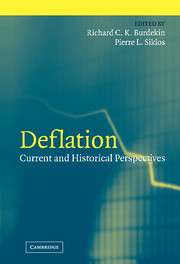Book contents
- Frontmatter
- Contents
- List of Tables and Figures
- List of Contributors
- Preface
- 1 Fears of Deflation and the Role of Monetary Policy: Some Lessons and an Overview
- PART ONE FEARS OF DEFLATION AND THE ROLE OF MONETARY POLICY
- PART TWO DEFLATION AND ASSET PRICES
- PART THREE INTERNATIONAL PERSPECTIVES ON DEFLATION
- 7 Is Deflation Depressing? Evidence From the Classical Gold Standard
- 8 The Strong Lira Policy and Deflation in Italy's Interwar Period
- 9 Deflation and Stagnation in Japan: Collapse of the Monetary Transmission Mechanism and Echo From the 1930s
- PART FOUR STOCK MARKET ADJUSTMENTS TO DEFLATION
- References
- Index
- Titles in the series
7 - Is Deflation Depressing? Evidence From the Classical Gold Standard
Published online by Cambridge University Press: 15 December 2009
- Frontmatter
- Contents
- List of Tables and Figures
- List of Contributors
- Preface
- 1 Fears of Deflation and the Role of Monetary Policy: Some Lessons and an Overview
- PART ONE FEARS OF DEFLATION AND THE ROLE OF MONETARY POLICY
- PART TWO DEFLATION AND ASSET PRICES
- PART THREE INTERNATIONAL PERSPECTIVES ON DEFLATION
- 7 Is Deflation Depressing? Evidence From the Classical Gold Standard
- 8 The Strong Lira Policy and Deflation in Italy's Interwar Period
- 9 Deflation and Stagnation in Japan: Collapse of the Monetary Transmission Mechanism and Echo From the 1930s
- PART FOUR STOCK MARKET ADJUSTMENTS TO DEFLATION
- References
- Index
- Titles in the series
Summary
INTRODUCTION
In the four decades before World War I, most of the countries in the world adhered to the classical gold standard. The period was characterized by two decades of secular deflation, followed by two decades of secular inflation. This early price level experience should be of great contemporary interest because most advanced countries have returned to an environment of price stability not terribly dissimilar to that of the classical gold standard era.
Deflation has had a “bad rap.” Possibly as a consequence of the combination of deflation and depression in the 1930s, deflation is associated with (for some, connotes) depression. On the face of it, the evidence from the late nineteenth century was mixed. On one hand, the mild deflation in the period 1870–1896 was accompanied by positive growth in many countries; however, growth accelerated during the period of inflation after 1896. We distinguish between good and bad deflations. In the former case, falling prices may be caused by aggregate supply (possibly driven by technology advances) increasing more rapidly than aggregate demand. In the latter case, declines in aggregate demand outpace any expansion in aggregate supply. This was the experience in the Great Depression (1929–1933) and the recession of 1919–1921, and may be the case in Japan today.
In this chapter, we focus on the price level and growth experience of the United States and Canada, 1870–1913. Both countries adhered to the international gold standard, under which the world price level was determined by the demand and supply of monetary gold, and each member followed the rule of maintaining convertibility of its national currency into a fixed weight of gold.
- Type
- Chapter
- Information
- DeflationCurrent and Historical Perspectives, pp. 191 - 217Publisher: Cambridge University PressPrint publication year: 2004
- 13
- Cited by

